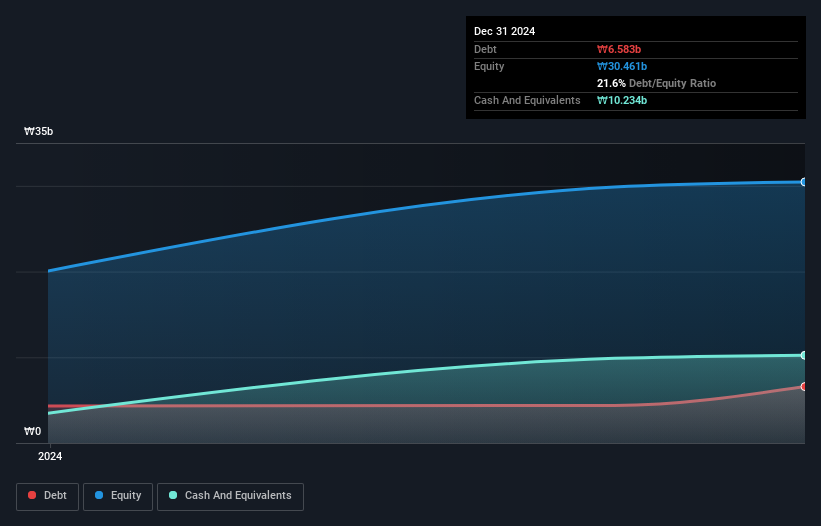- South Korea
- /
- Medical Equipment
- /
- KOSDAQ:A199550
Is Laseroptek (KOSDAQ:199550) Using Debt In A Risky Way?
Howard Marks put it nicely when he said that, rather than worrying about share price volatility, 'The possibility of permanent loss is the risk I worry about... and every practical investor I know worries about.' So it might be obvious that you need to consider debt, when you think about how risky any given stock is, because too much debt can sink a company. We can see that Laseroptek Co., Ltd. (KOSDAQ:199550) does use debt in its business. But should shareholders be worried about its use of debt?
What Risk Does Debt Bring?
Debt and other liabilities become risky for a business when it cannot easily fulfill those obligations, either with free cash flow or by raising capital at an attractive price. Part and parcel of capitalism is the process of 'creative destruction' where failed businesses are mercilessly liquidated by their bankers. While that is not too common, we often do see indebted companies permanently diluting shareholders because lenders force them to raise capital at a distressed price. Of course, the upside of debt is that it often represents cheap capital, especially when it replaces dilution in a company with the ability to reinvest at high rates of return. The first step when considering a company's debt levels is to consider its cash and debt together.
What Is Laseroptek's Net Debt?
As you can see below, at the end of December 2024, Laseroptek had ₩6.58b of debt, up from ₩4.33b a year ago. Click the image for more detail. But it also has ₩10.2b in cash to offset that, meaning it has ₩3.65b net cash.

How Healthy Is Laseroptek's Balance Sheet?
We can see from the most recent balance sheet that Laseroptek had liabilities of ₩10.7b falling due within a year, and liabilities of ₩4.18b due beyond that. Offsetting these obligations, it had cash of ₩10.2b as well as receivables valued at ₩15.0b due within 12 months. So it can boast ₩10.4b more liquid assets than total liabilities.
This surplus suggests that Laseroptek has a conservative balance sheet, and could probably eliminate its debt without much difficulty. Simply put, the fact that Laseroptek has more cash than debt is arguably a good indication that it can manage its debt safely. There's no doubt that we learn most about debt from the balance sheet. But you can't view debt in total isolation; since Laseroptek will need earnings to service that debt. So if you're keen to discover more about its earnings, it might be worth checking out this graph of its long term earnings trend.
Check out our latest analysis for Laseroptek
In the last year Laseroptek had a loss before interest and tax, and actually shrunk its revenue by 3.8%, to ₩33b. That's not what we would hope to see.
So How Risky Is Laseroptek?
By their very nature companies that are losing money are more risky than those with a long history of profitability. And we do note that Laseroptek had an earnings before interest and tax (EBIT) loss, over the last year. Indeed, in that time it burnt through ₩4.6b of cash and made a loss of ₩783m. Given it only has net cash of ₩3.65b, the company may need to raise more capital if it doesn't reach break-even soon. Overall, its balance sheet doesn't seem overly risky, at the moment, but we're always cautious until we see the positive free cash flow. The balance sheet is clearly the area to focus on when you are analysing debt. But ultimately, every company can contain risks that exist outside of the balance sheet. For example Laseroptek has 4 warning signs (and 2 which are potentially serious) we think you should know about.
When all is said and done, sometimes its easier to focus on companies that don't even need debt. Readers can access a list of growth stocks with zero net debt 100% free, right now.
New: AI Stock Screener & Alerts
Our new AI Stock Screener scans the market every day to uncover opportunities.
• Dividend Powerhouses (3%+ Yield)
• Undervalued Small Caps with Insider Buying
• High growth Tech and AI Companies
Or build your own from over 50 metrics.
Have feedback on this article? Concerned about the content? Get in touch with us directly. Alternatively, email editorial-team (at) simplywallst.com.
This article by Simply Wall St is general in nature. We provide commentary based on historical data and analyst forecasts only using an unbiased methodology and our articles are not intended to be financial advice. It does not constitute a recommendation to buy or sell any stock, and does not take account of your objectives, or your financial situation. We aim to bring you long-term focused analysis driven by fundamental data. Note that our analysis may not factor in the latest price-sensitive company announcements or qualitative material. Simply Wall St has no position in any stocks mentioned.
About KOSDAQ:A199550
Laseroptek
Develops and manufactures aesthetic and medical laser devices in South Korea.
Excellent balance sheet with low risk.
Market Insights
Weekly Picks


Crazy Undervalued 42 Baggers Silver Play (Active & Running Mine)


Fiducian: Compliance Clouds or Value Opportunity?

Willamette Valley Vineyards (WVVI): Not-So-Great Value
Recently Updated Narratives


ADNOC Gas future shines with a 21.4% revenue surge

Watch Pulse Seismic Outperform with 13.6% Revenue Growth in the Coming Years

Significantly undervalued gold explorer in Timmins, finally getting traction
Popular Narratives


MicroVision will explode future revenue by 380.37% with a vision towards success


NVDA: Expanding AI Demand Will Drive Major Data Center Investments Through 2026





